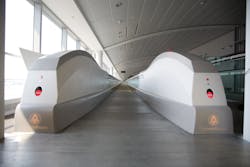Accelerate Your Terminal Traffic
To successfully navigate the sometimes choppy waters of airport management, aviation professionals must deal with a number of moving pieces beyond the passengers themselves—pieces that are not only challenging, but very costly. One of those costly challenges is, of course, delays.
The Federal Aviation Administration estimates flight delays in the U.S. cost airlines $22 billion every year. Between June 2015 and June 2016, approximately one million flights were delayed, equating to nearly 64 million minutes of delays, per the U.S. Bureau of Transportation Statistics. Most delays can be attributed to factors outside of an airport’s control. Nearly half of the aforementioned flight delays can be traced back to airline issues, such as aircraft maintenance, crew scheduling and refueling, while 30 percent of delays can be attributed to weather disturbances.
While not the primary culprit, airports share part of the blame for delaying some of the 2.5 million passengers that fly every day. Some of that blame falls on the antiquated pedestrian transportation systems airports are still relying on to move people from airport entrance to airplane entrance.
Further complicating matters is an aging population with reduced mobility that require assistance passing through crowded airports. The number of Americans ages 65 and older is projected to more than double by 2060, placing even greater demands on airport transportation. And on top of all that, airport expansions have further increased distances between gates, placing even greater stress on airport passengers and workers alike.
For some airports, the distance between gates can stretch more than one mile, although for most major airports, the longest distance is typically between one-half mile and one mile. Shuttles are often utilized for lengthy connections, but there are limitations with shuttles (space, frequency) that make other modes of transportation critically important.
Fortunately, technology advances in airport mobility have improved connection time successes and movement throughout airport facilities. But to continue to meet those increasing demands, airport operations professionals must embrace smarter pedestrian transportation, extending to the transit lines responsible for moving passengers and workers to and from an airport.
Walk This Way
The first moving walkway debuted in 1893 at the World’s Columbian Exposition in Chicago, and more than 60 years later, an airport installed a moving walkway (Love Field in Dallas). In the past, moving walkways have been criticized for either being too slow-moving or not decelerating early enough, creating safety hazards for distracted airport travelers.
But modern accelerated moving walkways not only remediate those past issues, but are alleviating increasing traffic congestion at airports, reducing connections times by as much as 70 percent. One such system features overlapping pallets, which allow each pallet to expand up to three times its original size. Passengers step on the walkway at a normal walking speed, and are then safely accelerated up to more than seven miles per hour before comfortably decelerating for safe exit.
It can take as little as 2 minutes, 20 seconds to cover up to 885 feet (270 m); with older technology, it would take as much as 7 minutes to cover that same distance. Looking at the sheer volume, the technology can transport up to 7,300 passengers per hour per direction.
This type of walkway, which can ultimately eliminate the need for airports to utilize shuttle buses or automated trains, is ideal for busy, large airports with a high volume of transfer traffic, such as Orlando International Airport. More than 20 million people pass through OIA annually, and earlier this year, a shuttle outage stranded 14,000 passengers for more than three hours.
And at airports like John F. Kennedy International Airport in New York where it is expected that the international hub will reach capacity in a decade, this type of walkway would greatly alleviate the congestion problems it will face. A $10 billion plan was unveiled to upgrade the facility, and as part of the upgrades, JFK will improve connection to its terminals.
These next-generation accelerated moving walkways apply linear motor technology from the Transrapid magnetic train; by comparison, traditional walkways use electric motors with a rotational motion. Transrapid is a high-speed monorail train that uses magnetic levitation, which means it has no wheels, axles, gear transmissions or steel rails. The first commercial installation occurred in 2004 when the Shanghai Maglev train was unveiled, which connects the city’s transit network to Shanghai Pudong International Airport.
Another way pedestrian transportation is improving at airports is through digitization.
Now Boarding: IoT
It was only a matter of time before the Internet of Things, or IoT, eventually landed and permanently taxied at airports worldwide. IoT, the networking of devices to collect and exchange data, creates immediate, actionable intelligence, which is critical in airports where it can be utilized to streamline security, baggage, building and security operations to improve efficiency.
There are numerous ways IoT can be utilized in airport operations, including aircraft maintenance and luggage tracking. But another area is within an airport’s pedestrian transportation systems, including its elevators.
Toronto’s Pearson International Airport, the busiest airport in Canada, has implemented cloud-based, real-time, predictive maintenance technology on its pedestrian transportation systems that allow for accurate maintenance planning and scheduling, which in turn ensures maximum uptime. Smart technology has the ability to capture all data associated with the elevator’s activity, including movement between floors, distance traveled, as well as frequency of elevator doors opening and closing by floor.
It also allows service technicians and airports to proactively identify parts or materials that are wearing and in need of replacement in advance of a potential failure. In short, smart technology allows airports and service technicians to assess the health of connected elevators and their components.
Smart technology also provides instant education and access to an elevator’s history, allowing new technicians to get up to speed quickly, which ultimately leads to expedition of service calls. A newer technology that will start to play a key role in this process is mixed-reality technology. A combination of augmented and virtual reality, mixed-reality has already made a significant impact in industries including military and health care, but its aviation-related application, its use has been limited. Via this technology, service technicians can have remote, hands-free access to technical and expert information while onsite, resulting in interventions that can be done up to four times faster than before.
Prior to heading to the airport, using mixed-reality technology, a technician can view a 3-D picture from all angles of the elevator and components to immediately visualize and identify the problems. And at the airport, the mixed-reality device can display a virtual desktop with an overview of task orders, safety alerts and notes on that elevator’s history. A video call can even be initiated by voice, allowing another engineer to remotely view what that technician is seeing while at the airport and working through any potential issues together.
Moving Forward
So what else is in store for pedestrian movement at airports in the short- and long-term? Ultimately, it could be a revolutionary elevator that can move travelers throughout an airport facility—vertically, horizontally, sideways and even diagonally. Using the same magnetic levitation technology as the aforementioned accelerated moving walkways, the first-ever rope-less elevator was unveiled to the public this year, and it can connect buildings or connect transit systems with buildings, efficiently moving high volumes of people throughout crowded airports.
At the end of the day, improving the passenger experience requires more than a friendly smile at ticketing, a short line at security and an on-time flight—it requires modern systems and processes that improve how a passenger goes from Point A to Point B. And thanks to mobility innovations and technological advances driven by the pedestrian movement industry, the future looks a lot brighter for those weary travelers.
Fabio Speggiorin is Vice President of Research and Development and Product Lifecycle Management for thyssenkrupp Elevator worldwide, a company with five large R&D centers, located in Germany, Spain, the United States, Brazil and China.
About the Author

